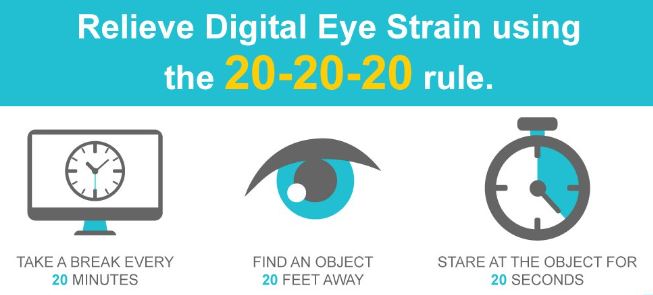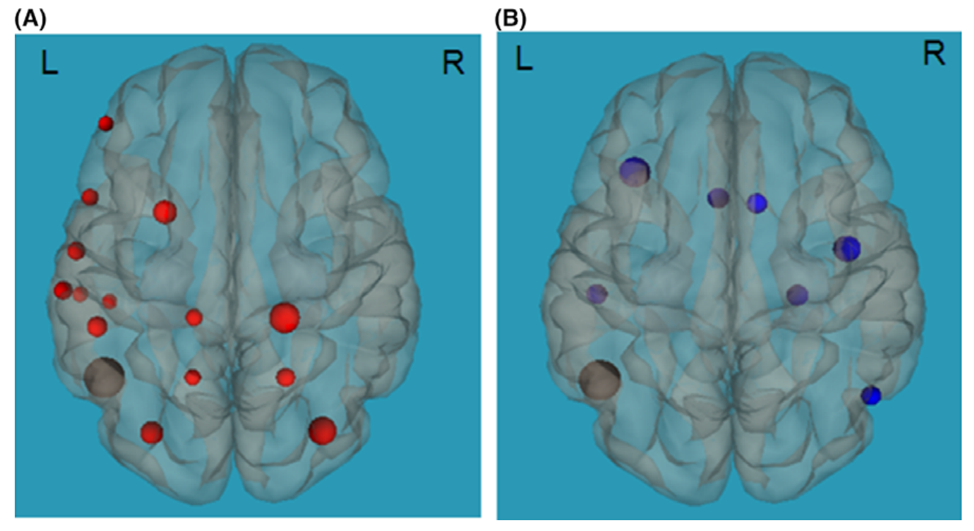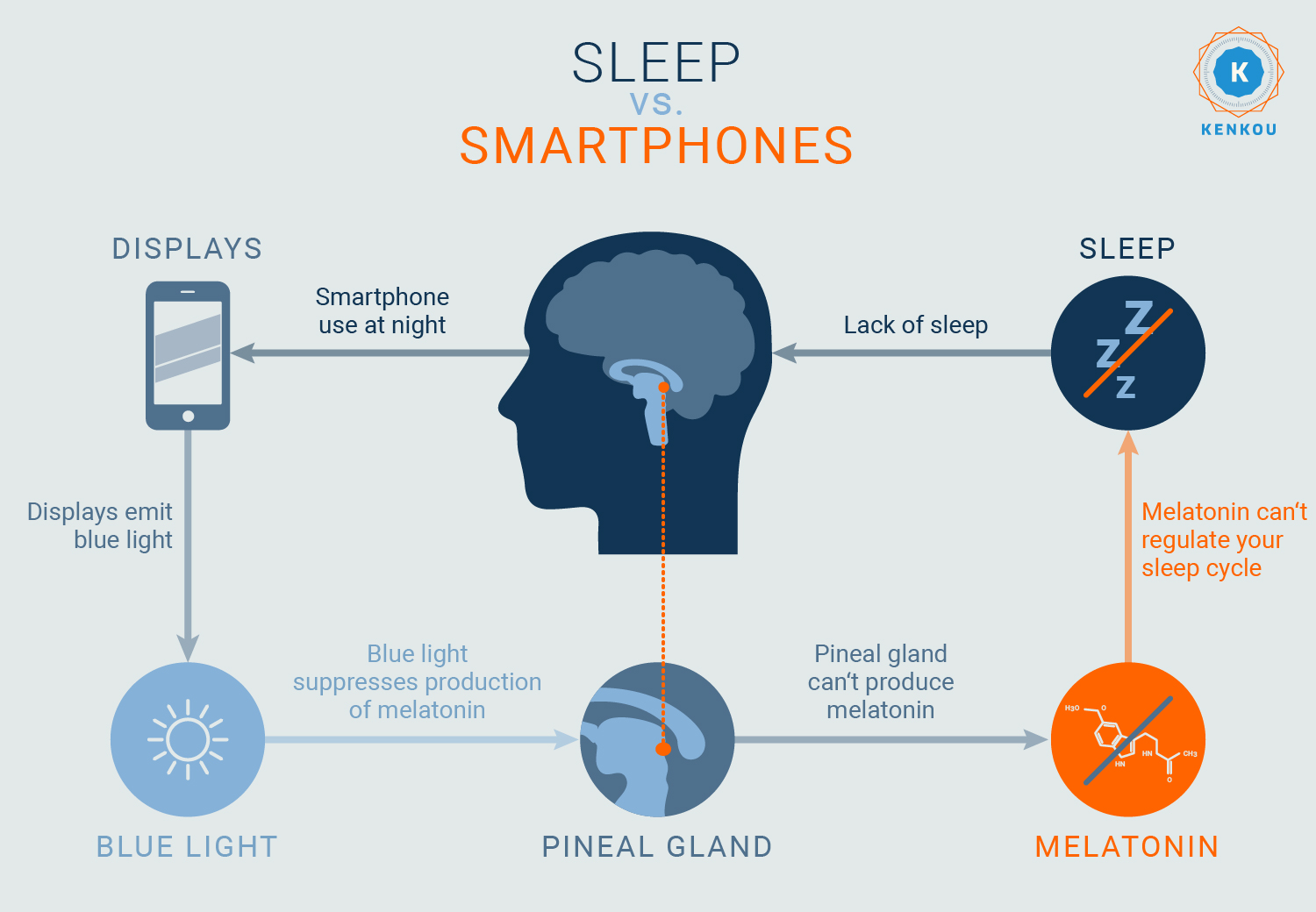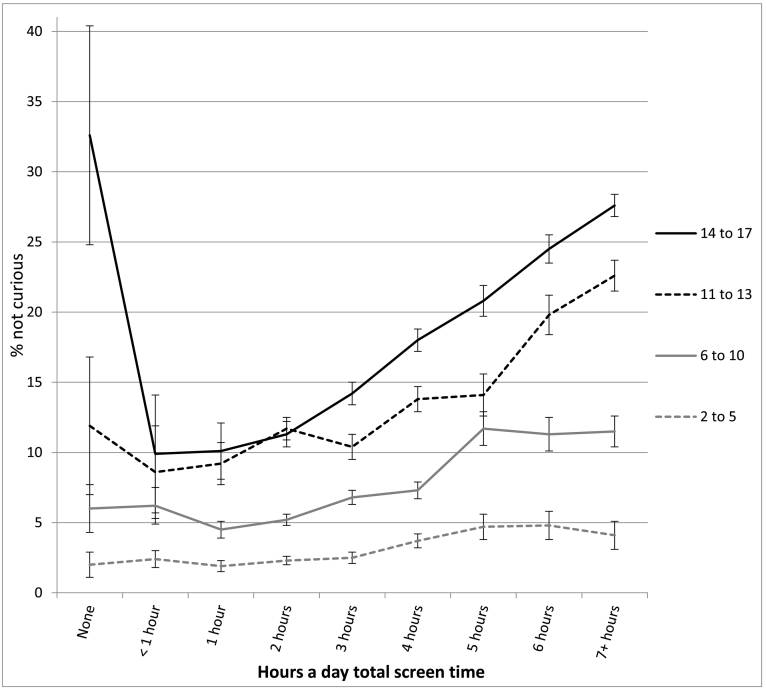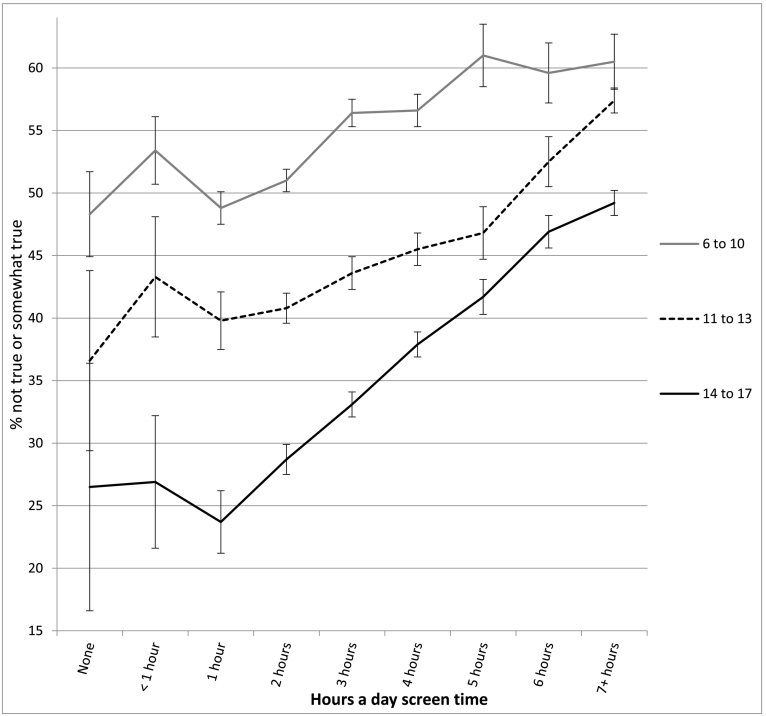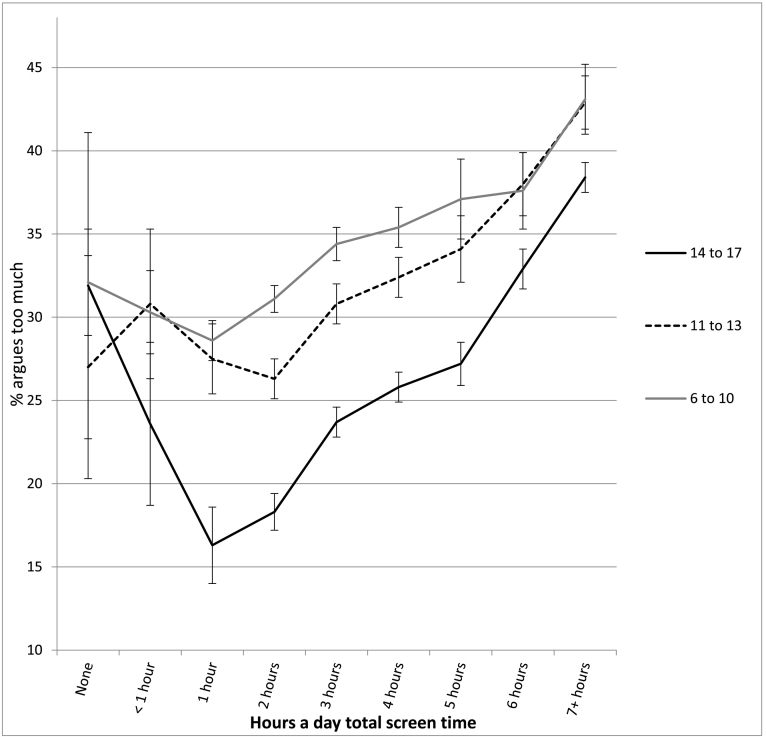This is an old revision of the document!
Table of Contents
Presentation Slides
Introduction
As university students, we are always trying to efficiently manage our time. One such revolutionary method to do this has clearly been technology! Technology offers so many benefits that traditional methods could never achieve. For example, the platform in which you are reading this is a computer as opposed to written notes! You use this same media for many things, whether it be watching shows, playing games, reading, socializing etc. It is truly wonderful how much can be accomplished with just this computer, but you have to wonder how much time you spend online and if it’s good for you. Have you ever stopped and thought about the effect of excessive screen time on your eyes, brain or behaviour? Surely at some point or another you have realized that you must cut down on your screen time and find healthier habits. We know that it can’t be good to be on our computers all the time, yet we never actually thought about why it might be bad. In contrast, we obviously use technology because it offers so much compared to conventional method. Therefore, our presentation and wiki sought to examine the pros and the cons of screen time.
Effects on the Eyes
As humans living in today’s world, it is impossible to spend a day without looking at a screen at least once! Our eyes are constantly exposed to digital texts, lights, and animations. Constant overexposure to these stimuli over a long period of time can cause a condition known as Digital Eye Strain (DES), also known as Computer Vision Syndrome. There is no one cause for this condition and it can affect people of all ages (Sheppard & Wolffsohn, 2018).
Symptoms of DES
Common symptoms include irritation of the eyes, blurred vision, headaches, as well as neck and shoulder pain (Sheppard & Wolffsohn, 2018). Irritation of the eyes can include dryness which is attributed to the fact that humans tend to blink less and squint more while looking at a screen. A study by Tsubota and Nakamori (1993) compared mean blink rates in three different scenarios: relaxed, reading a book, and viewing a screen. Results showed that the mean blink rate was 22 blinks/minute when relaxed, 11 blinks/minute when reading a book, and 7 blinks/minute when viewing a screen (Tsubota & Nakamori, 1993). Another factor that contributes to eye dryness is the gaze angle. When looking at a screen, a higher gaze angle means that more of the cornea is exposed to the light from the screen which would result in an increase in tear evaporation, further drying the eyes (Rosenfield, 2016). This ultimately causes us to experience irritation and our eyes will fatigue easily.
Blue Light Exposure
Another way prolonged exposure to screens can be harmful to the eyes is through the blue light emitted from digital screens. Blue is classified as a high-energy colour due to its short wavelength (400-500nm). Exposure to light with such high energy can induce photochemical damage to the retina (Sheppard & Wolffsohn, 2018). Research have shown that high-energy photons can interfere with the biochemical bonds between molecules that compose the tissues in our eyes by breaking these bonds (Mellerio, 1994). When these bonds are broken, there is a higher chance of the formation of free radicals which are detrimental to cells and tissue. Free radicals can cause protein and DNA damage due to oxidative stress which can eventually drive cells, such as photoreceptors, into apoptosis (Mellerio, 1994). However, such damage can occur as a result of an unnaturally prolonged exposure to blue light emitted from digitals screen, as shown by the research. And thus, blue light is not considered as hazardous.
Prevention and Treatment
The main treatment for digital eye strain is giving the eyes a proper rest. Symptoms of eye dryness can also be alleviated by using lubricating or hydrating eye drops. However, DES can be avoided by following the 20-20-20 rule, as shown in Figure 1.
Figure 1. Infographic depicting the recommended practice for the prevention of DES, as proposed by The American Optometric Association. The 20-20-20 rule states that for every 20 minutes spent looking at a screen, a 20 second break should be taken where the person spends it staring at an object 20 feet away.
Effects on the Brain
Excessive screen time has a strong negative impact on the brain and affects the structure, functions and neuroreceptors of the brain. High exposure to electronic screens can lead to neuroadaptation and structural changes in regions of the brain associated with addiction (Sigman, 2017). Screen dependency disorders such as Internet Addiction Disorder (IAD), can cause neurogenetic polymorphisms, abnormal neural tissue and impact neural function (Sigman, 2017). These impacts will have a negative impact on a person’s neurological development and well-being, especially if they are a child and their brain is still developing.
Structural Abnormalities
The structure of the brain goes through a lot of changes during the second decade of life. The main structural abnormalities discovered are gray and white matter atrophy as well as cortical thickness reduction and changing sulcal depths (Paulus et al., 2019). A study conducted by Paulus et al., (2019) discovered that people with high exposure to screens had a thinner cortex, reduced gray and white matter, lower brain volume and a more complicated pattern of changes in sulcal depth. A lack of development of white matter tracts will slow down brain processing speed and connections between brain cells and the rest of the nervous system (Dunckley, 2014). The reduced volume and cortical thickness in the frontolimbic regions can actually be predictors of psychopathology in adolescents (Paulus et al, 2019). An interesting discovery was that the structural differences caused by excessive screen time impacts the same regions as drug addiction (Sigman, 2017). This includes dopamine-rich areas of the basal ganglia, such as the ventral tegmental area, caudate nucleus, thalamus and amygdala (Sigman, 2017). Therefore, excessive screen time can be classified as an addiction to many people.
Sigman (2017) discussed how differences in gray and white mater in the prefrontal region and limbic structures were observed in those who viewed screens excessively. These people also had lower functional connectivity in the fronto-striatal circuits and impaired executive functioning and inhibitory control (Sigman, 2017). Thus, tasks controlled by the frontal lobe such as planning and organizing become impaired. Volume loss in the striatum was also witnessed, which affects reward pathways and dopamine activity, which will be discussed in the neuroreceptor abnormalities section (Dunckley, 2014). A study using diffusion tensor imaging was conducted on 248 healthy children between ages 5-17 and found a correlation between the average hours of screen time and microstructural changes over a 3-year period (Sigman, 2017). A reduction in tissue density and neural plasticity was observed, especially in the dopaminergic system (Sigman, 2017). Thus, it was found that screen time is linked to delayed microstructure development (Sigman, 2017). Another study on college students found that those who were dependent on their phones had larger right caudate and nucleus accumbens – both linked to reduced cognitive control (Sigman, 2017).
Functional Abnormalities
Staring at a screen for too long can also cause a decrease of functional connectivity in the brain, as tested on children aged 8-12 (Horowitz-Kraus & Hutton, 2018). The study compared how functional connectivity varied between kids who spent time using a screen and those who read books. It was concluded that time spent reading was positively correlated to higher functional connectivity between the visual form area and language, visual and cognitive control regions located on the left side of the brain (Horowitz-Kraus & Hutton, 2018). A higher functional connectivity will result in faster and stronger signals transmitted between the areas. Kids who used screens more had lower connectivity between the seed area and brain regions corresponding to language and cognitive control (Horowitz-Kraus & Hutton, 2018).
Figure 2: Comparison of functional connectivity of kids who used a screen and those who read books. The figure shows the correlation between time spent either reading or looking at a screen, and the visual word form area (Brodmann area 37) with other Brodmann areas. The visual word form area is represented in both images with a black dot. Figure 2A: Positive correlation was found between functional connectivity of the visual word form area and reading, language and cognitive control regions (red dots) when reading. Figure 2B: Negative correlation found between functional connectivity of the visual word form area and reading, language and cognitive control regions (blue dots) when looking at a screen. (Horowitz-Kraus & Hutton, 2018)
Another study used functional neuroimaging to find that internet addiction and high screen times were associated with a decrease in functional connectivity, specifically in the cortico-striatal circuits (Hong et al., 2013). However, this decrease was not linked to global disruption in the brain's functional network topology. This proved that differences in functional connectivity can exist without alterations in the basic topological measures of the brain (Hong et al., 2013). Sigman (2017) discussed how internet addiction and high screen time affects the same connections and networks in the brain as drug addiction. The more severe the addiction, the lower the efficiency of white matter networks and shorter the path lengths (Sigman, 2017). Overall, high screen times caused functional network dysfunction and impaired executive control.
Neuroreceptor Abnormalities
High screen time impacts the neuroreceptors in our brain, especially dopamine. Dopamine allows us to feel pleasure and plays a role in our ability to plan and think. Those who constantly look at a screen have reduced dopamine D2 receptors available in their striatum and lower dopamine transporters expressed (Sigman, 2017). This is linked to decreased glucose metabolism in the orbitofrontal cortex of the brain which signifies a dysregulation of the orbitofrontal cortex, causing a loss of control (Sigman, 2017). When playing video games, dopamine levels released from the reward pathways are especially high. However, long term, high concentrations of dopamine can cause lesions in the dopamine terminal and overall decreased dopaminergic cell body size (Hou et al., 2012). To identify people with an addiction disorder, blunted striatal dopaminergic function is one of the key biological mechanisms that is impacted and noticeable (Hong et al., 2013). A study by Hou et al., (2012) tested if the striatal dopamine transporter (DAT) levels were different in people who were addicted to the internet and screens. Using single photon emission computed tomography, they found that DAT was significantly lower in people who used screens excessively (Hou et al., 2012). DAT is a protein found in the presynaptic terminal and striatal DAT helps with active dopamine reuptake into the presynaptic neuron. Thus, it helps regulate the striatal synaptic dopamine levels and those who use screens a lot will suffer from dopamine dysregulation (Hou et al., 2012).
Effects on Sleep
It has long been proven that sufficient sleep duration is essential for healthy mental and physical functioning (Twenge et al., 2017). Sleep problems in adolescents have been on the rise over the past decade. Electronic media use has been concluded to play a large role in reduced sleep durations (Foerster et al., 2019). Notably, media screen time has recently increased due to the gain in popularity of smartphones and similar devices (Twenge et al., 2017). This media use occurs in the form of time spent watching television, engaging in video games and cellphone use.
Emission of Short-Wavelength Blue Light
A common explanation for lowered sleep quality is that the light emitted from these screens disrupts the users’ circadian rhythms (Bowler & Bourke, 2019). The circadian rhythm is the 24-hour biological cycle that influences physical, mental and behavioural functions. Its primary function is that it determines the body’s sleep-wake cycle. The circadian rhythm needs signals from the external environment, particularly light and darkness, in order to adjust itself (Bowler and Bourke, 2019). Blue-wavelength light is what stimulated the sensors in one’s eyes in order to send signals to the brain’s internal clock (Bowler and Bourke, 2019). When the human body is exposed to different wavelength lights at the wong hours of the day, it can confuse our body's and thus effect our sleep cycle.
Overall, studies indicate that the use of computer screen before one sleeps, has a direct physiological effect due to the light that is emitted from the screen. Lights with shorter wavelengths, specifically those within the blue range of around 460-480 nm, produce the most melatonin suppression (Bowler & Bourke, 2019). Light of blue wavelength are important with regards to circadian rhythms, because they create the strongest response from the ipRGC receptors (Bowler and Bourke, 2019). The disruption in circadian rhythms likely occurs due to pre-sleep exposure to blue wavelength light that comes from screens (Bowler & Bourke, 2019). When participants view devices through clear glasses with attached blue light-emitting diodes (LED) melatonin increase is significantly suppressed in comparison to devices viewed through orange-tinted glasses which block blue light (Bowler & Bourke, 2019). This effect occurs due to the circadian rhythm phase delay that results in delayed onset of drowsiness and sleep (Bowler & Bourke, 2019).
Figure 3: Infographic showcasing the detrimental effect of using a smartphone, and related devices in the evening. Such electronics emit a blue light, which thus alters the circadian rhythm and causes a suppression in the the production of melatonin at night (Bowler & Bourke, 2019). As a result, the pineal gland is unable to produce melatonin, which is it's normal function during evening hours (Bowler & Bourke, 2019). Due to this, the melatonin is unable to regulate the sleep cycle, ultimately disrupting sleep.
Effects on Acute Evening Alertness and Morning Sleepiness
The suppression of melatonin leads to the increase of self-perceived alertness which ultimately delays the onset of sleep (Bowler & Bourke, 2019). In particular, use of the light-emitting electronic devices reduces the amount and delays the timing of REM sleep, ultimately reducing alertness the next morning. In a presented study, the effects of reading an electronic book was compared with that of a printed book in the hours before individuals went to bed (Chang et al., 2014). Reading an eBook was associated with decreased sleepiness in the evening and increased sleepiness in the morning (Chang et al., 2014). The study concluded that this was due to the circadian-phase delay (Chang et al., 2014). The evening light from the eBook delays the circadian clock, which then delays the base of the circadian rhythm of the sleep predisposition, which ultimately has an indirect effect on an individual’s level of morning tiredness (Chang et al., 2014). In addition to this, the individuals within the experimental group took longer to fully wake up and have a lower level of alertness compared to the control group (Chang et al., 2014).
Preventative Strategies to Limit Biological Effects
The usage of light-emitting devices before bedtime is an area of concern due to the fact that light is the most powerful environmental signal that has an impact on the human circadian clock and thus, hold a hand in perpetuating sleep deficiency (Chang et al., 2014). For optimal sleep duration and quality, the timing of the sleep episode must align properly with that of the circadian clock (Chang et al., 2014). Even a 15 to 30-minute exposure to screen time is sufficient enough to cause a significantly low quality of sleep (Bowler & Bourke, 2019). The resulting biological effects resultantly have severe impacts on performance, health and safety (Chang et al., 2014).
Experts recommend a handful of strategies in order to reduce the exposure to the blue light before bed. A given is to completely avoid exposure to light-emitting electronic devices during the evening and night (Gringras et al., 2015). It is suggested to avoid exposure to blue-light for 2-3 hours before going to bed (Gringras et al., 2015). Employing orange-tinted glasses or adding a filter to the screen are both seen as effective solutions (Gringras et al., 2015). This effect occurs due to the fact that the glasses are able to cancel out the melatonin-suppressing effect of the blue light. In addition, many computers now have the option of night mode, as well as programs such as f.lux which adjust the colour and brightness of screens based on the timezone. When it is dark, both of these block all blue light, by adding an orange hue to computers.
Sedentary Behaviour and Screen Time
A large, associated concern with the increased trends in screen time is the increasingly prevalent sedentary behaviour of individuals. For reference, the Canadian sedentary behaviour guidelines state that individuals should limit the amount of time they spend being sedentary and should additionally limit screen time to no more than 2 hours per day (Tremblay et al., 2011). These guidelines were created by the Canadian Society for Exercise Physiology as they noted that the physical activity of Canadians have decreased, contrasted with an increasing obesity and disease rate (Colley et al. 2011). This makes sense as sedentary behaviour implies a lack of exercise, which tends to be positively correlated with longevity.
From a study conducted on Chinese adolescents, boys self-reported watching television on average from 1.5 – 3.7 hours a day and girls reported 1.4 – 3.0 hours a day (Cao et al., 2011). While this time spent watching television decreases with age, it is still important to note that the time reported is solely on watching television. This means that it does not include time spent on computer based activities such as gaming, studying, browsing the internet etc. Therefore, it is reasonable to assume that the actual daily screen time for these individuals is greater than what they reported.
Evidently, there is a huge reliance in modern society on the use of technology; with technological advances, there is an associated increased reliance. For example, in the USA, one of the most developed countries in the world, it is predicted that infants from 8-18 years old spend more than 7 hours per day looking at screens (Rideout, Foehr, & Roberts, 2010). As mentioned previously, this is time that isn’t spent on healthier recreational activities and can actually be detrimental to health in the long-term. In a meta-analysis examining the effects of screen-time sedentary behaviour on depression, they found that treatment groups had a 12.3% increased chance of depression in comparison to the control groups (Zhai, Zhang, & Zhang, 2015). Interestingly, the results indicated limiting screen time to approximately 1 hour a day was associated with a reduced risk of depression while screen time greater than 2 hours was continuously associated with increasing risks of depression.
Previous studies indicate that the amount of time that adults spend watching television decreases with age. However, this isn’t representative of the amount of time adults spend sedentary, while taking into account screen time. Data suggests that American adults actually spend around 7.7 hours per day sitting down (Ford & Casperson, 2012). Additionally, the average American adult’s daily calorie expenditure has decreased by nearly 142 calories per day. This study by Ford and Casperson (2012), suggests that sedentary behaviour and screen time are associated with an increased risk of fatal and non-fatal cardiovascular disease. Future studies are required for conclusive results associating cardiovascular disease and sedentary behaviour due to screen time, but this is still important data that should be heeded.
Mental Disorders Linked to Screen Time
The National Institute of Health estimates that kids spend approximately 5-7 hours daily using screens for entertainment. This is almost double the amount of time kids spent 10 years ago. According to several studies and Dr. Peggy Scallon, screen time is one of the major reasons for increased case of anxiety, depression and many other mental health problems in kids (Scallon et al., 2018). Increased screen time means that kids spend less time with their family and friends and therefore, do not get enough face to face interaction, causing them to grow up in a harmful mental health environment. Dr. Heather Jones explains that kids usually try to avoid dealing with anxiety and depression by using their phones, TV and games. However, in the long run, this leads to an increased feeling of anxiety and depression. Therefore, the American Academy of Pediatrics has recommended less than two hours of entertainment screen time daily for children above age 2 (Scallon et al., 2018).
Children below the age of 2 need the stimuli from real world in order to develop certain skills. Multiple studies have found that increased screen time exposure in children below the age of 2 is linked with cognitive delay. Without the interactions in real life, children lose the ability to communicate successfully. Children’s behaviour is another aspect that is significantly affected by screen time. Several studies have linked increased screen time to several behavioural problems such as outbursts, controlling behaviour and extreme competitiveness (Twenge et al., 2018). Electronic devices give children instant satisfaction and this could cause impatience and attention issues. For instance, a recent study showed that using digital media can double the risk of developing attention issues (Twenge et al., 2018).
In addition, another study found out that children who spent 7 hours or more daily on screens are more than twice as likely to experience anxiety and depression, compared to those who only use screens for an hour daily (Twenge et al., 2018). Moderate users who spent 4 hours daily on screens were also associated with lower well-being. This study was done on 40,000 kids from 2-17 years old. This sample was designed to be a good representative of all United states children. 9,361 were 2-5 years old, 10,668 were 6-10 years old, 7,555 were 11-13 years old and 12,753 were 14-17 years old. On the survey, two different types of questions were asked. The first was in regards to screen time on TV and video games and the second question was in regards to screen time on cellphones and other digital devices. The number of hours spent on both was then added and separated into eight different categories (Twenge et al., 2018).
Approximately 20% of children between 14-17 years old spent 7 hours using screens, each day. Along with depression and anxiety, they also found out that they were not able to focus properly and found it harder to finish their tasks without getting distracted. As seen in figure 4, with an increase in screen time, the percentage of kids who were curious and interested in learning new things also increased significantly. Between 14-17 years old, moderate uses (users who spent around 4 hours on screens) were 78% more likely not to be curious or willing to learn (Twenge et al., 2018).
Figure 4: The relationship between the hours spent on screen and % of kids not being curious. The sample contained kids between the ages of 2-17.
In addition, a positive correlation was found between screen time and percentage of kids who were not able to stay calm when challenged with difficult tasks or situations. As seen in figure 5, as screen time increases, the percentage of kids not being able to stay calm during challenges also increases. Between 14-17 years old, moderate users were 60% more likely not to stay calm during challenging situations (Twenge et al., 2018)
Figure 5: The relationship between the hours spent on screen and % of kids not being able to stay calm while facing challenges. The sample contains kids between the ages of 6-17.
Furthermore, a positive correlation was also found between increased screen time and those who argue with their caregivers more. For instance, between 14-17 years old, moderate users were 57% more likely to argue with their caregivers compared to those who used screens less (Twenge et al., 2018).
Figure 6: The relationship between the hours spent on screen and % of kids arguing much with their caregivers. The sample contains kids between the ages of 6-17.
These negative trends were more serious in adolescents compared to young children. Dr. Jean Twenge believed that this is due to the fact that adolescents and teens spend more time on social media and on their phones, compared to young children who spend the majority of their time watching TV (Heid et al., 2018).
References
Bowler, J., & Bourke, P. (2019). Facebook use and sleep quality: Light interacts with socially induced alertness. British Journal of Psychology, 110(3), 519-529.
Cao, H., Qian, Q., Weng, T., Yuan, C., Sun, Y., Wang, H., & Tao, F. (2011). Screen time, physical activity and mental health among urban adolescents in China. Preventive medicine, 53(4-5), 316-320.
Chang, A. M., Aeschbach, D., Duffy, J. F., & Czeisler, C. A. (2015). Evening use of light-emitting eReaders negatively affects sleep, circadian timing, and next-morning alertness. Proceedings of the National Academy of Sciences, 112(4), 1232-1237.
Colley, R. C., Garriguet, D., Janssen, I., Craig, C. L., Clarke, J., & Tremblay, M. S. (2011). Physical activity of Canadian adults: accelerometer results from the 2007 to 2009 Canadian Health Measures Survey. Health reports, 22(1), 7.
Dunckley, V. L. (2014). Gray matters: Too much screen time damages the brain. Psychology Today, 27.
Foerster, M., Henneke, A., Chetty-Mhlanga, S., & Röösli, M. (2019). Impact of adolescents’ screen time and nocturnal mobile phone-related awakenings on sleep and general health symptoms: a prospective cohort study. International journal of environmental research and public health, 16(3), 518.
Ford, E. S., & Caspersen, C. J. (2012). Sedentary behaviour and cardiovascular disease: a review of prospective studies. International journal of epidemiology, 41(5), 1338-1353.
Heid, M. (2018, October 29). There's Worrying New Research About Kids' Screen Time and Their Mental Health. Retrieved from https://time.com/5437607/smartphones-teens-mental-health/
Hong, S. B., Zalesky, A., Cocchi, L., Fornito, A., Choi, E. J., Kim, H. H., … & Yi, S. H. (2013). Decreased functional brain connectivity in adolescents with internet addiction. PloS one, 8(2).
Horowitz‐Kraus, T., & Hutton, J. S. (2018). Brain connectivity in children is increased by the time they spend reading books and decreased by the length of exposure to screen‐based media. Acta paediatrica, 107(4), 685-693.
Hou, H., Jia, S., Hu, S., Fan, R., Sun, W., Sun, T., & Zhang, H. (2012). Reduced striatal dopamine transporters in people with internet addiction disorder. BioMed Research International, 2012.
How does screen time affect kids' mental health? (n.d.). Retrieved from https://rogersbh.org/about-us/newsroom/blog/how-does-screen-time-affect-kids-mental-health
Mellerio, J. (1994). Principles and practice of ophthalmology. Light Effects on the Retina, 116, 1-23.
Paulus, M. P., Squeglia, L. M., Bagot, K., Jacobus, J., Kuplicki, R., Breslin, F. J., … & Tapert, S. F. (2019). Screen media activity and brain structure in youth: Evidence for diverse structural correlation networks from the ABCD study. Neuroimage, 185, 140-153.
Rideout, V. J., Foehr, U. G., & Roberts, D. F. (2010). Generation M 2: Media in the Lives of 8-to 18-Year-Olds. Henry J. Kaiser Family Foundation.
Rosenfield, M., & Portello, J. (2015). Computer Vision Syndrome and Blink Rate. Current Eye Research, 1-2. doi: 10.3109/02713683.2015.1031352
Sigman, A. (2017). Screen Dependency Disorders: a new challenge for child neurology. J Int Child Neurol Ass, 17, 119.
Tremblay, M. S., LeBlanc, A. G., Janssen, I., Kho, M. E., Hicks, A., Murumets, K., … & Duggan, M. (2011). Canadian sedentary behaviour guidelines for children and youth. Applied Physiology, Nutrition, and Metabolism, 36(1), 59-64.
Tsubota, K., & Nakamori, K. (1993). Dry Eyes and Video Display Terminals. New England Journal Of Medicine, 328(8), 584-584. doi: 10.1056/nejm199302253280817
Twenge, J. M., & Campbell, W. K. (2018). Associations between screen time and lower psychological well-being among children and adolescents: Evidence from a population-based study. Preventive Medicine Reports, 12, 271–283. doi: 10.1016/j.pmedr.2018.10.003
Twenge, J. M., Krizan, Z., & Hisler, G. (2017). Decreases in self-reported sleep duration among US adolescents 2009–2015 and association with new media screen time. Sleep medicine, 39, 47-53.
Zhai, L., Zhang, Y., & Zhang, D. (2015). Sedentary behaviour and the risk of depression: a meta-analysis. Br J Sports Med, 49(11), 705-709.
